One of the many perks of teaching Social Studies classes during an election year is the amazing opportunity we have to connect current events to the content we are teaching. It’s fabulous! This year, however, it’s no secret that the presidential campaigns, specifically the mudslinging, name-calling, and less than PG rated debates are not characteristic of modern presidential races. Sure, Andrew Jackson and John Quincy Adams had some interesting remarks to hurl at their opponents, and those comments were no doubt scandalous during their time. During one of the 2012 debates, President Obama told Mitt Romney that the 1980s called and wanted their foreign policy back. Snarky? Yes. Comparable to the discussions in the 20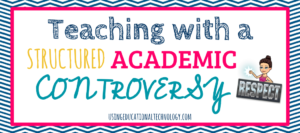 16 debates? Not quite … in my opinion. (No … this is not a post advocating for either candidate!) If you’re looking for an activity to encourage your students to analyze both sides of an issue and you’re not comfortable with allowing your students to debate … because, let’s be honest, “debating” in classes can turn into exactly what we see on television from our presidential candidates … try a Structured Academic Controversy!
16 debates? Not quite … in my opinion. (No … this is not a post advocating for either candidate!) If you’re looking for an activity to encourage your students to analyze both sides of an issue and you’re not comfortable with allowing your students to debate … because, let’s be honest, “debating” in classes can turn into exactly what we see on television from our presidential candidates … try a Structured Academic Controversy!
According to teachinghistory.org, a Structured Academic Controversy is “a discussion that moves students beyond either/or debates to a more nuanced historical synthesis.” It seems as though so much discussion today starts with “this is what I think,” and as soon as someone disagrees, the discussion turns into “you’re wrong,” or “wow, you don’t know anything about this issue,” and sometimes an even more heated argument transpires. This is not the goal of debates – at least in the classroom setting!
We want students to form educated opinions after discussing issues with their peers … not arguing and slinging insults at each other!
The goal of a Structured Academic Controversy … at least in my classroom … is for my students to view and analyze information the provides background about an issue and a perspective on said issue, then clearly and RESPECTFULLY communicate their given “side” to others in their group. I want my students to practice listening to their classmates and not just hearing the words they say. Then, after all perspectives have been heard, I want my students to come to a consensus with their group about that issue.
Here’s how it worked in my classroom:
The Electoral College is always an interesting and highly debatable topic in my American Government classroom … especially during a presidential election season. We’re studying the United States Constitution now, and with the constant talk of electoral maps and the path to the presidency, this SAC seemed like a perfect fit!
I found and amazing lesson from Bill of Rights Institute on the Electoral College that helped provide resources for this activity. In fact, I tweaked what I found on this lesson and plugged it into my Structured Academic Controversy template.
To give my students some guidance, I started with a review of the Electoral College … how it works, why our founders thought we needed it, and then how it can impact the outcome of presidential elections. Then, I shared this document through Google Classroom that provided them with the task of the activity and the resources they need to help shape their claim.
I then divided my students into groups of four-five students and then created two teams in each group. Team 1 was to discuss the Electoral College from the perspective of someone who believed it was vital to our American political system today, while Team 2 was to share the opposite perspective.
Each large group was to view/analyze the resources I provided and then answer the two “furthering your knowledge” questions.
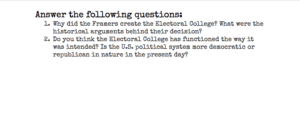 Next, each team was to identify and list three reasons to support their claim and provide evidence from the resources to support their claim … all kinds of Common Core standards here!
Next, each team was to identify and list three reasons to support their claim and provide evidence from the resources to support their claim … all kinds of Common Core standards here!
When the teams were ready, each group began with Team 1 sharing their perspective and claim. While Team 1 was speaking, all members of Team 2 were actively listening to the other side. They were taking notes on the other team’s information and were only allowed to interrupt Team 1 to clarify their statements. When Team 1 had stated their perspective and their “reasons why,” Team 2 would first read their notes/summary of Team 1’s claim to them. If there were no questions or clarifications that needed to be made. Team 2 would read their claim and reasons, and the process would be repeated with Team 1 listening and taking notes.
When both sides had stated their perspectives, they were allowed to abandon their original “sides” and were told to come to a consensus as a table. All discussion was required to be respectful and on topic. Basically, I told my students to think about how the presidential debates have been during this election and told my students NOT TO ACT LIKE THAT! Quite sad, isn’t it?
The result?
This. Was. FANTASTIC! I was so excited at the result of the activity that I gave each student 20 Bonus XP, I texted my husband after the class period and told him about how amazing my kids did, and then I tweeted about it. My teacher heart was SWELLING with PRIDE!
This Structured Academic Controversy took 4 50 minute class periods to complete. Day 1 was spent reviewing and re-teaching the Electoral College and any misconceptions that students had about this institution … I even sang a few “raps” to help them with the concepts 🙂 Day 2 was spent viewing/analyzing resources in groups and beginning to answer the “furthering your knowledge” questions. Day 3 was spent establishing three claims and supporting evidence from the resources. Day 4 was the big day … Discussion day!
As for grading … I observed students on three criteria as outlined in the rubric below.
As students were leaving my class after the last day, I asked them how they felt about the activity. Their response nearly made me do cartwheels around my classroom … “I really feel like I understand the Electoral College better now” was the overwhelming response from my classes. Be still my teacher-heart!!!
Will I do this again? Absolutely!
Have you used Structured Academic Controversies in your classes? I’d love to hear your experiences!
Thanks for reading this super long post 🙂
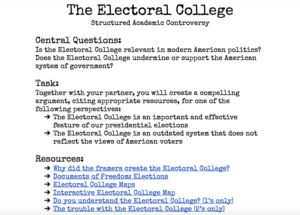
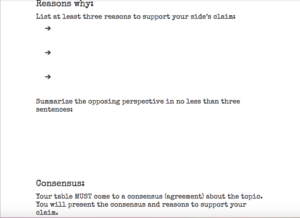
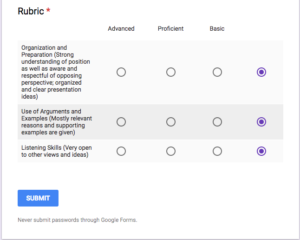

It was helpful reading SAC activity and example made it real. Stay blessed
Would you be willing to email your created documents? Or post them all here? I can’t see the full sheets.
Hey!
Thanks for your comment! I’ll post these documents asap.
Thanks for stopping by!
Bethany
Hi!
I was looking for the documents as well and I can’t find them 🙁 Can you tell me where they are posted?
Thanks!